Evaluating Clinical Leadership Theories and Their Impact on Nursing
VerifiedAdded on 2023/06/03
|8
|1983
|432
Essay
AI Summary
This essay explores the crucial role of clinical leadership in nursing, emphasizing its impact on patient care and the overall healthcare environment. It reviews four articles discussing clinical leadership theories and their application in nursing practice. The essay highlights the importance of leadership skills for nurses to improve patient outcomes, address challenges in the clinical setting, and promote a healthy work environment. It also discusses the need for comprehensive training programs to equip nurses with essential leadership skills. The essay concludes by recommending continuous learning and curriculum development to enhance clinical leadership among nurses, ultimately improving the quality and safety of patient care. Desklib offers a variety of solved assignments and study resources for students.

Running Head: NURSING ASSIGNMENT
Nursing Assignment
Name
Institution
Nursing Assignment
Name
Institution
Paraphrase This Document
Need a fresh take? Get an instant paraphrase of this document with our AI Paraphraser
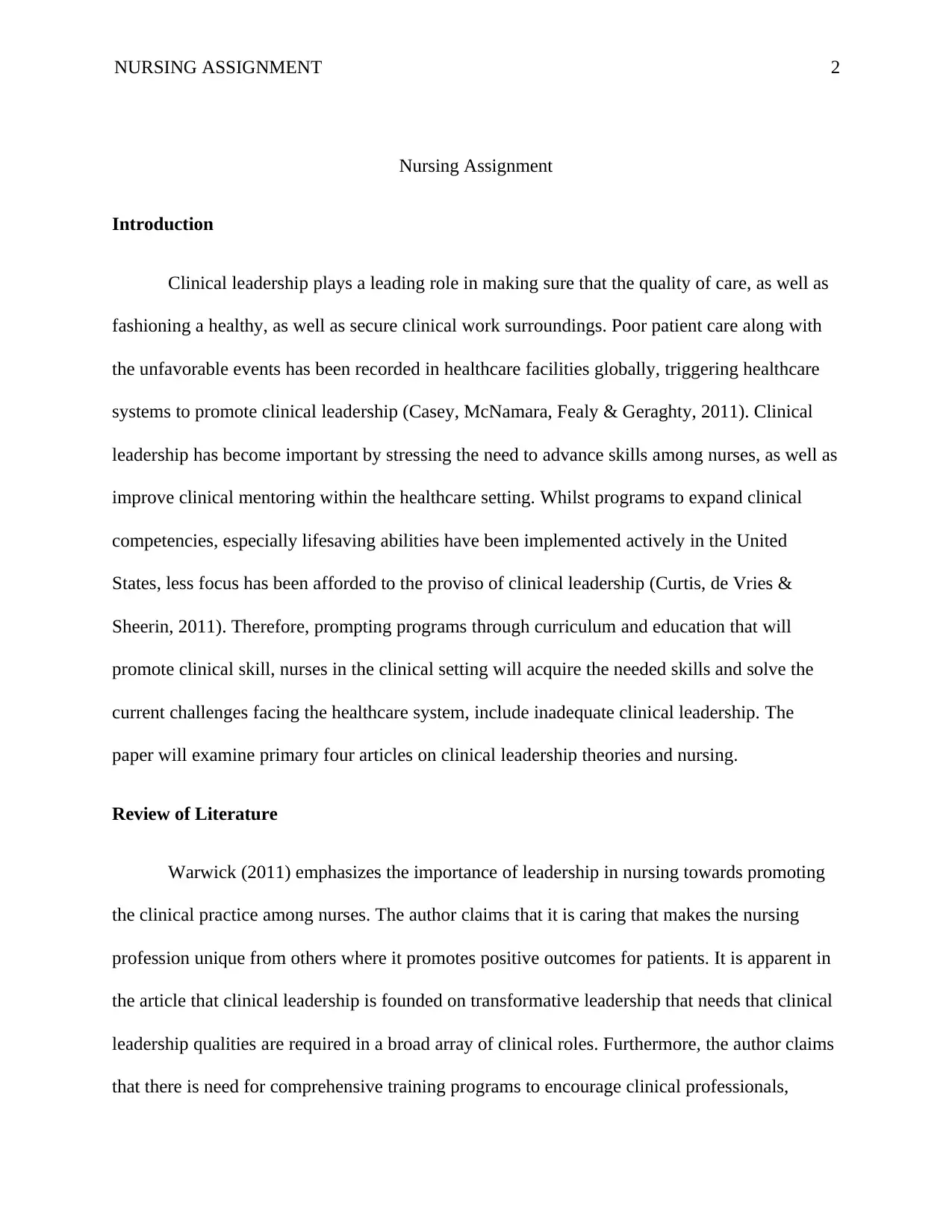
NURSING ASSIGNMENT 2
Nursing Assignment
Introduction
Clinical leadership plays a leading role in making sure that the quality of care, as well as
fashioning a healthy, as well as secure clinical work surroundings. Poor patient care along with
the unfavorable events has been recorded in healthcare facilities globally, triggering healthcare
systems to promote clinical leadership (Casey, McNamara, Fealy & Geraghty, 2011). Clinical
leadership has become important by stressing the need to advance skills among nurses, as well as
improve clinical mentoring within the healthcare setting. Whilst programs to expand clinical
competencies, especially lifesaving abilities have been implemented actively in the United
States, less focus has been afforded to the proviso of clinical leadership (Curtis, de Vries &
Sheerin, 2011). Therefore, prompting programs through curriculum and education that will
promote clinical skill, nurses in the clinical setting will acquire the needed skills and solve the
current challenges facing the healthcare system, include inadequate clinical leadership. The
paper will examine primary four articles on clinical leadership theories and nursing.
Review of Literature
Warwick (2011) emphasizes the importance of leadership in nursing towards promoting
the clinical practice among nurses. The author claims that it is caring that makes the nursing
profession unique from others where it promotes positive outcomes for patients. It is apparent in
the article that clinical leadership is founded on transformative leadership that needs that clinical
leadership qualities are required in a broad array of clinical roles. Furthermore, the author claims
that there is need for comprehensive training programs to encourage clinical professionals,
Nursing Assignment
Introduction
Clinical leadership plays a leading role in making sure that the quality of care, as well as
fashioning a healthy, as well as secure clinical work surroundings. Poor patient care along with
the unfavorable events has been recorded in healthcare facilities globally, triggering healthcare
systems to promote clinical leadership (Casey, McNamara, Fealy & Geraghty, 2011). Clinical
leadership has become important by stressing the need to advance skills among nurses, as well as
improve clinical mentoring within the healthcare setting. Whilst programs to expand clinical
competencies, especially lifesaving abilities have been implemented actively in the United
States, less focus has been afforded to the proviso of clinical leadership (Curtis, de Vries &
Sheerin, 2011). Therefore, prompting programs through curriculum and education that will
promote clinical skill, nurses in the clinical setting will acquire the needed skills and solve the
current challenges facing the healthcare system, include inadequate clinical leadership. The
paper will examine primary four articles on clinical leadership theories and nursing.
Review of Literature
Warwick (2011) emphasizes the importance of leadership in nursing towards promoting
the clinical practice among nurses. The author claims that it is caring that makes the nursing
profession unique from others where it promotes positive outcomes for patients. It is apparent in
the article that clinical leadership is founded on transformative leadership that needs that clinical
leadership qualities are required in a broad array of clinical roles. Furthermore, the author claims
that there is need for comprehensive training programs to encourage clinical professionals,
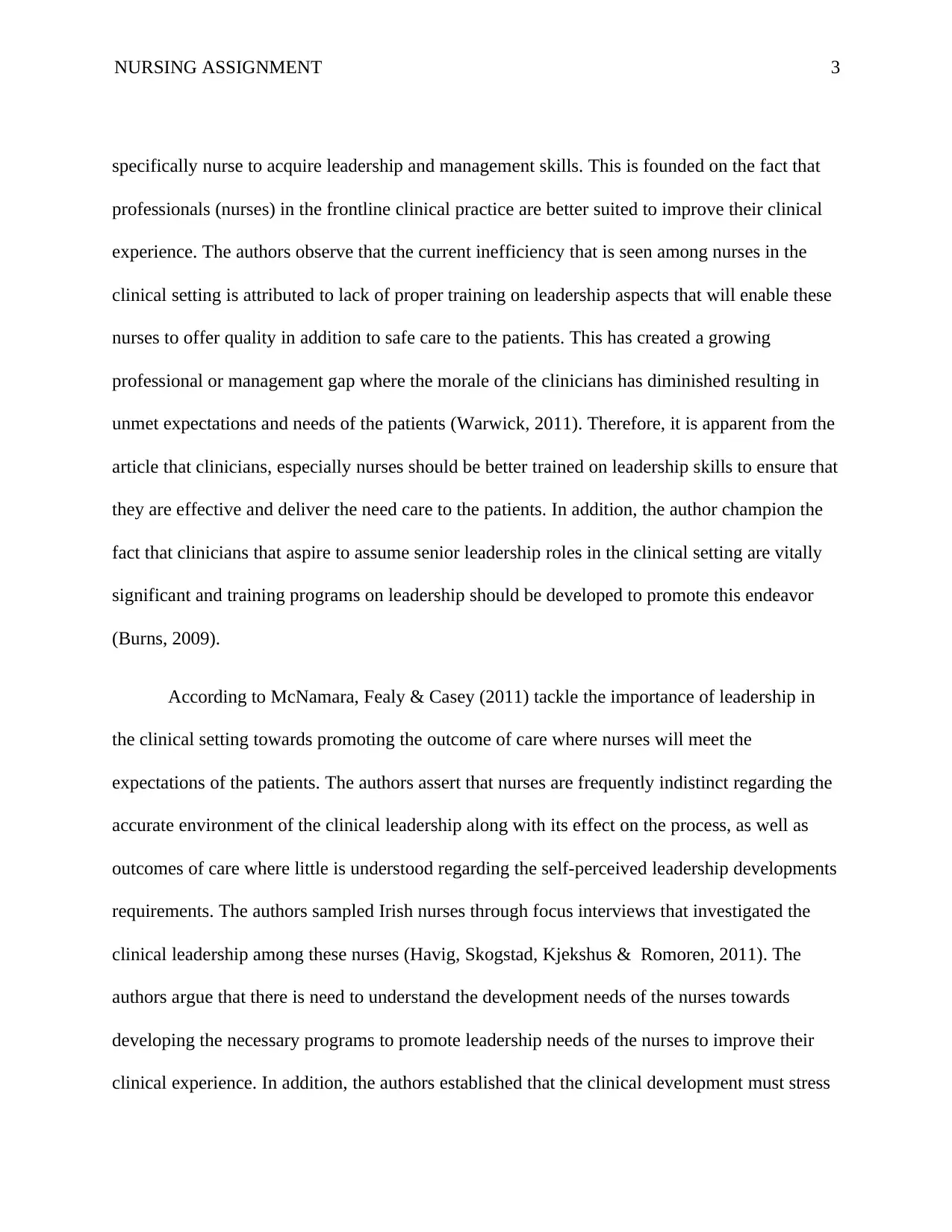
NURSING ASSIGNMENT 3
specifically nurse to acquire leadership and management skills. This is founded on the fact that
professionals (nurses) in the frontline clinical practice are better suited to improve their clinical
experience. The authors observe that the current inefficiency that is seen among nurses in the
clinical setting is attributed to lack of proper training on leadership aspects that will enable these
nurses to offer quality in addition to safe care to the patients. This has created a growing
professional or management gap where the morale of the clinicians has diminished resulting in
unmet expectations and needs of the patients (Warwick, 2011). Therefore, it is apparent from the
article that clinicians, especially nurses should be better trained on leadership skills to ensure that
they are effective and deliver the need care to the patients. In addition, the author champion the
fact that clinicians that aspire to assume senior leadership roles in the clinical setting are vitally
significant and training programs on leadership should be developed to promote this endeavor
(Burns, 2009).
According to McNamara, Fealy & Casey (2011) tackle the importance of leadership in
the clinical setting towards promoting the outcome of care where nurses will meet the
expectations of the patients. The authors assert that nurses are frequently indistinct regarding the
accurate environment of the clinical leadership along with its effect on the process, as well as
outcomes of care where little is understood regarding the self-perceived leadership developments
requirements. The authors sampled Irish nurses through focus interviews that investigated the
clinical leadership among these nurses (Havig, Skogstad, Kjekshus & Romoren, 2011). The
authors argue that there is need to understand the development needs of the nurses towards
developing the necessary programs to promote leadership needs of the nurses to improve their
clinical experience. In addition, the authors established that the clinical development must stress
specifically nurse to acquire leadership and management skills. This is founded on the fact that
professionals (nurses) in the frontline clinical practice are better suited to improve their clinical
experience. The authors observe that the current inefficiency that is seen among nurses in the
clinical setting is attributed to lack of proper training on leadership aspects that will enable these
nurses to offer quality in addition to safe care to the patients. This has created a growing
professional or management gap where the morale of the clinicians has diminished resulting in
unmet expectations and needs of the patients (Warwick, 2011). Therefore, it is apparent from the
article that clinicians, especially nurses should be better trained on leadership skills to ensure that
they are effective and deliver the need care to the patients. In addition, the author champion the
fact that clinicians that aspire to assume senior leadership roles in the clinical setting are vitally
significant and training programs on leadership should be developed to promote this endeavor
(Burns, 2009).
According to McNamara, Fealy & Casey (2011) tackle the importance of leadership in
the clinical setting towards promoting the outcome of care where nurses will meet the
expectations of the patients. The authors assert that nurses are frequently indistinct regarding the
accurate environment of the clinical leadership along with its effect on the process, as well as
outcomes of care where little is understood regarding the self-perceived leadership developments
requirements. The authors sampled Irish nurses through focus interviews that investigated the
clinical leadership among these nurses (Havig, Skogstad, Kjekshus & Romoren, 2011). The
authors argue that there is need to understand the development needs of the nurses towards
developing the necessary programs to promote leadership needs of the nurses to improve their
clinical experience. In addition, the authors established that the clinical development must stress
⊘ This is a preview!⊘
Do you want full access?
Subscribe today to unlock all pages.

Trusted by 1+ million students worldwide
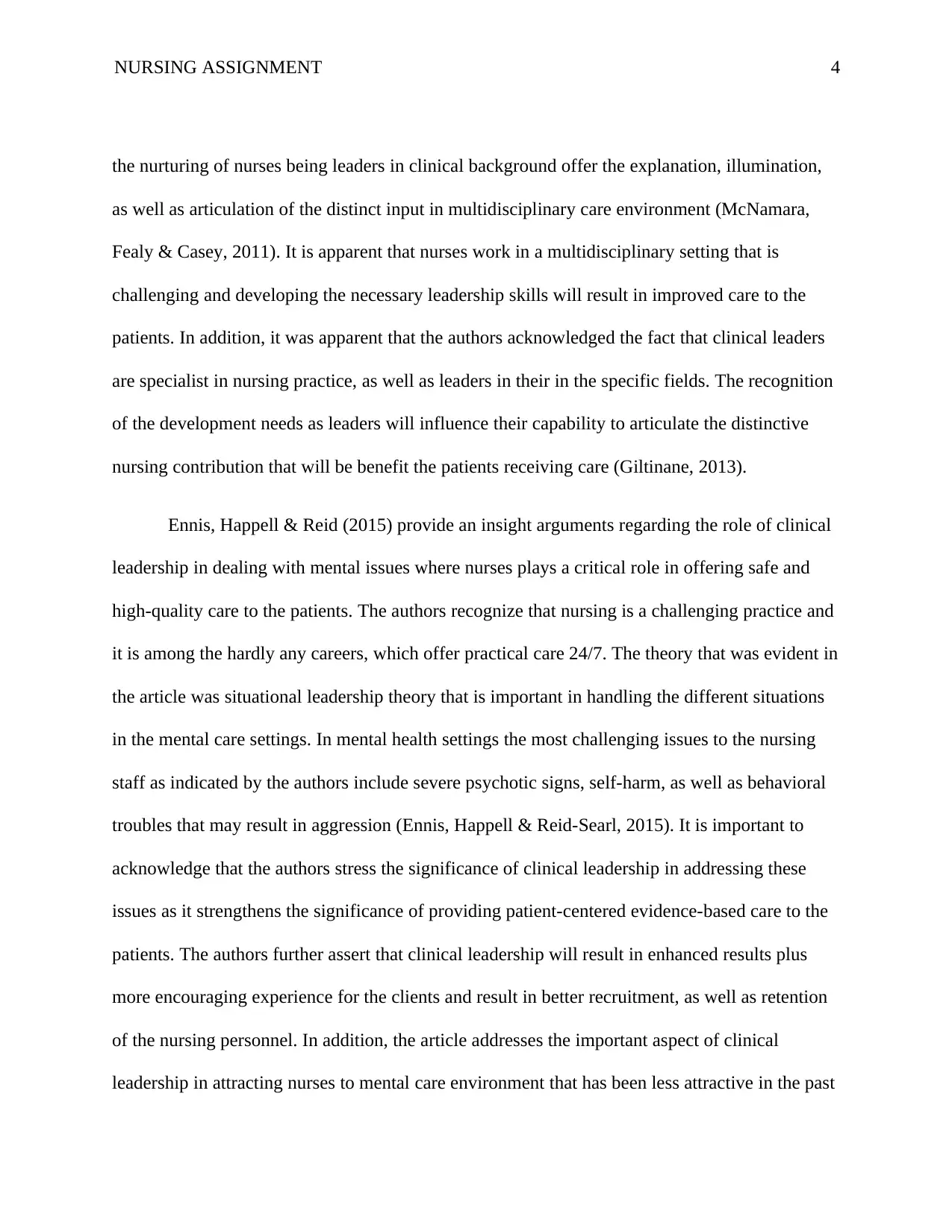
NURSING ASSIGNMENT 4
the nurturing of nurses being leaders in clinical background offer the explanation, illumination,
as well as articulation of the distinct input in multidisciplinary care environment (McNamara,
Fealy & Casey, 2011). It is apparent that nurses work in a multidisciplinary setting that is
challenging and developing the necessary leadership skills will result in improved care to the
patients. In addition, it was apparent that the authors acknowledged the fact that clinical leaders
are specialist in nursing practice, as well as leaders in their in the specific fields. The recognition
of the development needs as leaders will influence their capability to articulate the distinctive
nursing contribution that will be benefit the patients receiving care (Giltinane, 2013).
Ennis, Happell & Reid (2015) provide an insight arguments regarding the role of clinical
leadership in dealing with mental issues where nurses plays a critical role in offering safe and
high-quality care to the patients. The authors recognize that nursing is a challenging practice and
it is among the hardly any careers, which offer practical care 24/7. The theory that was evident in
the article was situational leadership theory that is important in handling the different situations
in the mental care settings. In mental health settings the most challenging issues to the nursing
staff as indicated by the authors include severe psychotic signs, self-harm, as well as behavioral
troubles that may result in aggression (Ennis, Happell & Reid-Searl, 2015). It is important to
acknowledge that the authors stress the significance of clinical leadership in addressing these
issues as it strengthens the significance of providing patient-centered evidence-based care to the
patients. The authors further assert that clinical leadership will result in enhanced results plus
more encouraging experience for the clients and result in better recruitment, as well as retention
of the nursing personnel. In addition, the article addresses the important aspect of clinical
leadership in attracting nurses to mental care environment that has been less attractive in the past
the nurturing of nurses being leaders in clinical background offer the explanation, illumination,
as well as articulation of the distinct input in multidisciplinary care environment (McNamara,
Fealy & Casey, 2011). It is apparent that nurses work in a multidisciplinary setting that is
challenging and developing the necessary leadership skills will result in improved care to the
patients. In addition, it was apparent that the authors acknowledged the fact that clinical leaders
are specialist in nursing practice, as well as leaders in their in the specific fields. The recognition
of the development needs as leaders will influence their capability to articulate the distinctive
nursing contribution that will be benefit the patients receiving care (Giltinane, 2013).
Ennis, Happell & Reid (2015) provide an insight arguments regarding the role of clinical
leadership in dealing with mental issues where nurses plays a critical role in offering safe and
high-quality care to the patients. The authors recognize that nursing is a challenging practice and
it is among the hardly any careers, which offer practical care 24/7. The theory that was evident in
the article was situational leadership theory that is important in handling the different situations
in the mental care settings. In mental health settings the most challenging issues to the nursing
staff as indicated by the authors include severe psychotic signs, self-harm, as well as behavioral
troubles that may result in aggression (Ennis, Happell & Reid-Searl, 2015). It is important to
acknowledge that the authors stress the significance of clinical leadership in addressing these
issues as it strengthens the significance of providing patient-centered evidence-based care to the
patients. The authors further assert that clinical leadership will result in enhanced results plus
more encouraging experience for the clients and result in better recruitment, as well as retention
of the nursing personnel. In addition, the article addresses the important aspect of clinical
leadership in attracting nurses to mental care environment that has been less attractive in the past
Paraphrase This Document
Need a fresh take? Get an instant paraphrase of this document with our AI Paraphraser
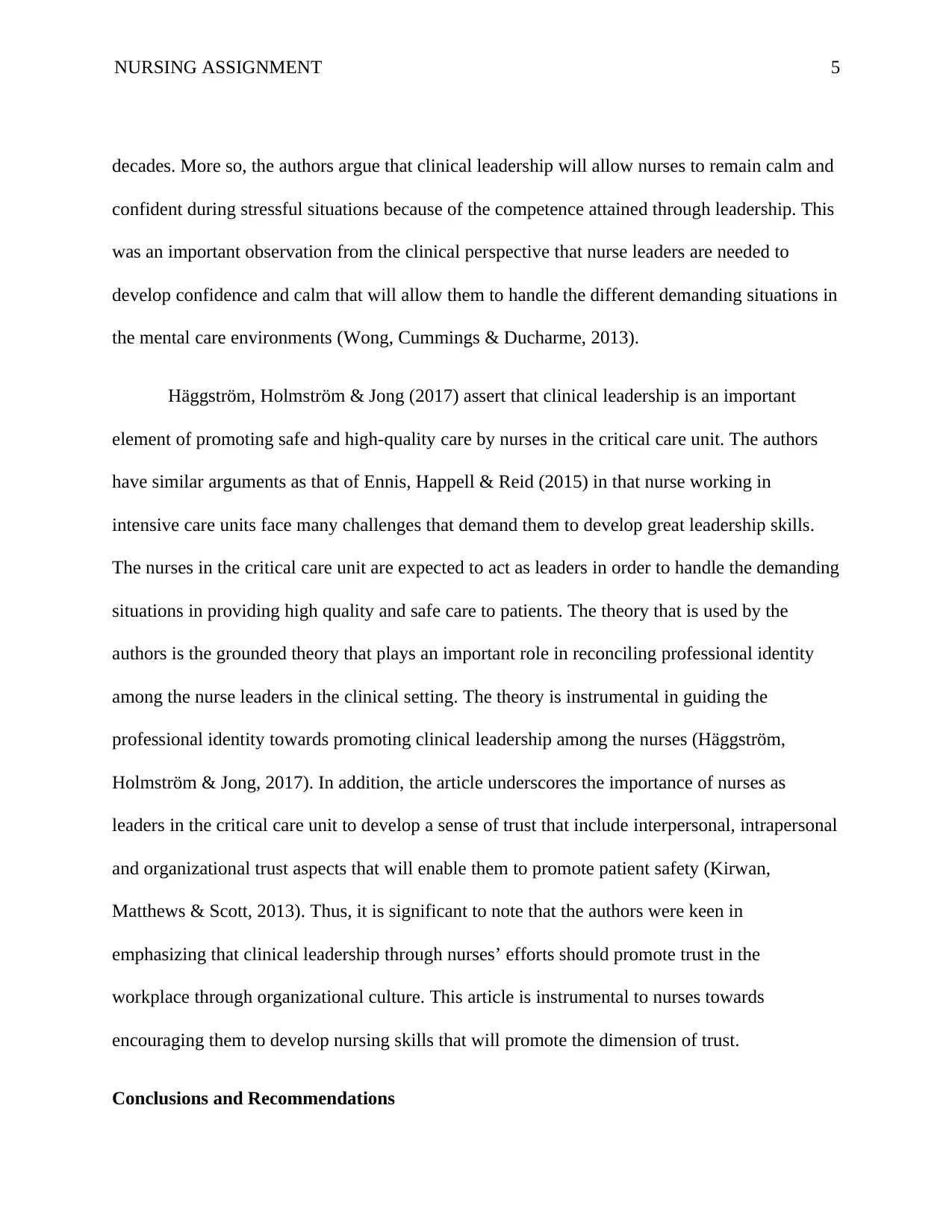
NURSING ASSIGNMENT 5
decades. More so, the authors argue that clinical leadership will allow nurses to remain calm and
confident during stressful situations because of the competence attained through leadership. This
was an important observation from the clinical perspective that nurse leaders are needed to
develop confidence and calm that will allow them to handle the different demanding situations in
the mental care environments (Wong, Cummings & Ducharme, 2013).
Häggström, Holmström & Jong (2017) assert that clinical leadership is an important
element of promoting safe and high-quality care by nurses in the critical care unit. The authors
have similar arguments as that of Ennis, Happell & Reid (2015) in that nurse working in
intensive care units face many challenges that demand them to develop great leadership skills.
The nurses in the critical care unit are expected to act as leaders in order to handle the demanding
situations in providing high quality and safe care to patients. The theory that is used by the
authors is the grounded theory that plays an important role in reconciling professional identity
among the nurse leaders in the clinical setting. The theory is instrumental in guiding the
professional identity towards promoting clinical leadership among the nurses (Häggström,
Holmström & Jong, 2017). In addition, the article underscores the importance of nurses as
leaders in the critical care unit to develop a sense of trust that include interpersonal, intrapersonal
and organizational trust aspects that will enable them to promote patient safety (Kirwan,
Matthews & Scott, 2013). Thus, it is significant to note that the authors were keen in
emphasizing that clinical leadership through nurses’ efforts should promote trust in the
workplace through organizational culture. This article is instrumental to nurses towards
encouraging them to develop nursing skills that will promote the dimension of trust.
Conclusions and Recommendations
decades. More so, the authors argue that clinical leadership will allow nurses to remain calm and
confident during stressful situations because of the competence attained through leadership. This
was an important observation from the clinical perspective that nurse leaders are needed to
develop confidence and calm that will allow them to handle the different demanding situations in
the mental care environments (Wong, Cummings & Ducharme, 2013).
Häggström, Holmström & Jong (2017) assert that clinical leadership is an important
element of promoting safe and high-quality care by nurses in the critical care unit. The authors
have similar arguments as that of Ennis, Happell & Reid (2015) in that nurse working in
intensive care units face many challenges that demand them to develop great leadership skills.
The nurses in the critical care unit are expected to act as leaders in order to handle the demanding
situations in providing high quality and safe care to patients. The theory that is used by the
authors is the grounded theory that plays an important role in reconciling professional identity
among the nurse leaders in the clinical setting. The theory is instrumental in guiding the
professional identity towards promoting clinical leadership among the nurses (Häggström,
Holmström & Jong, 2017). In addition, the article underscores the importance of nurses as
leaders in the critical care unit to develop a sense of trust that include interpersonal, intrapersonal
and organizational trust aspects that will enable them to promote patient safety (Kirwan,
Matthews & Scott, 2013). Thus, it is significant to note that the authors were keen in
emphasizing that clinical leadership through nurses’ efforts should promote trust in the
workplace through organizational culture. This article is instrumental to nurses towards
encouraging them to develop nursing skills that will promote the dimension of trust.
Conclusions and Recommendations
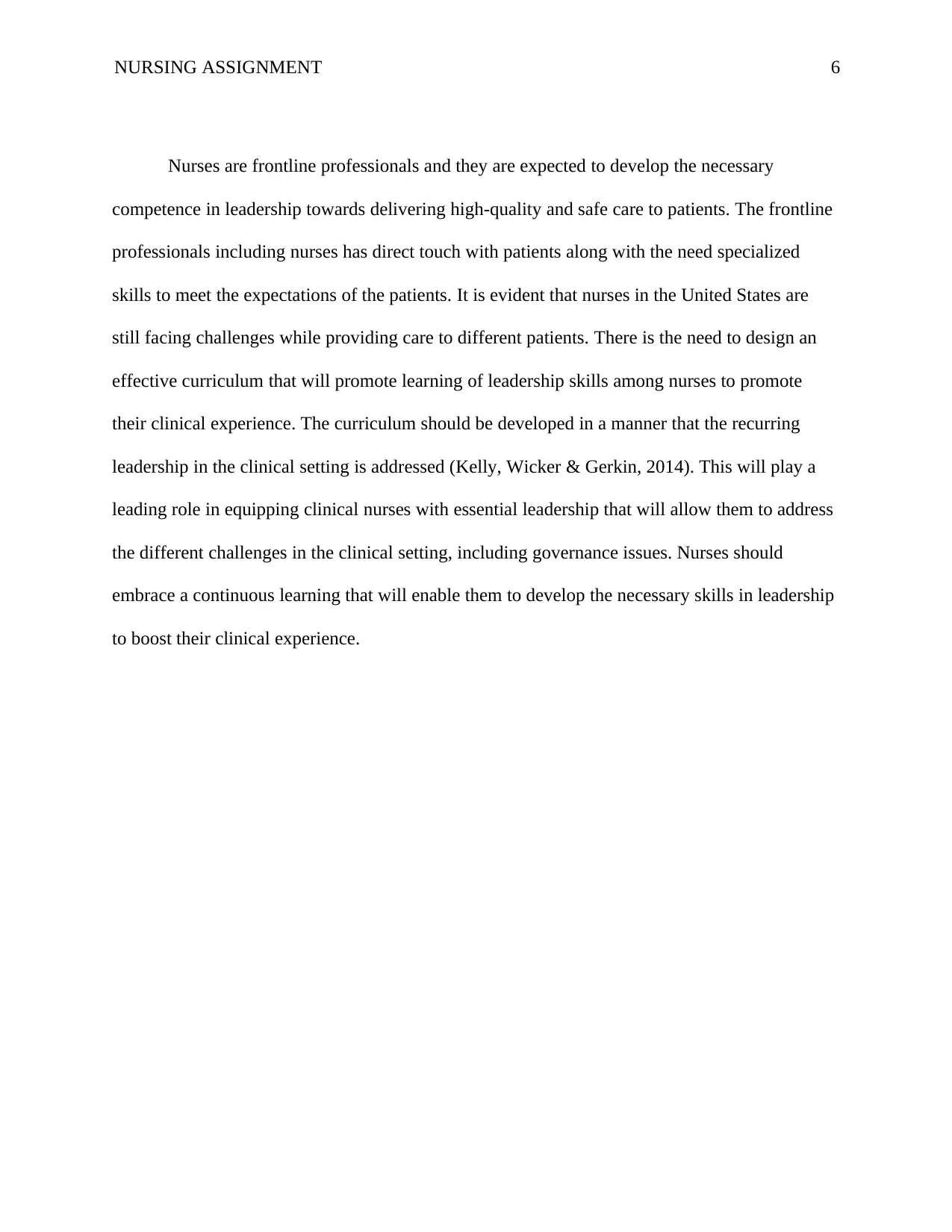
NURSING ASSIGNMENT 6
Nurses are frontline professionals and they are expected to develop the necessary
competence in leadership towards delivering high-quality and safe care to patients. The frontline
professionals including nurses has direct touch with patients along with the need specialized
skills to meet the expectations of the patients. It is evident that nurses in the United States are
still facing challenges while providing care to different patients. There is the need to design an
effective curriculum that will promote learning of leadership skills among nurses to promote
their clinical experience. The curriculum should be developed in a manner that the recurring
leadership in the clinical setting is addressed (Kelly, Wicker & Gerkin, 2014). This will play a
leading role in equipping clinical nurses with essential leadership that will allow them to address
the different challenges in the clinical setting, including governance issues. Nurses should
embrace a continuous learning that will enable them to develop the necessary skills in leadership
to boost their clinical experience.
Nurses are frontline professionals and they are expected to develop the necessary
competence in leadership towards delivering high-quality and safe care to patients. The frontline
professionals including nurses has direct touch with patients along with the need specialized
skills to meet the expectations of the patients. It is evident that nurses in the United States are
still facing challenges while providing care to different patients. There is the need to design an
effective curriculum that will promote learning of leadership skills among nurses to promote
their clinical experience. The curriculum should be developed in a manner that the recurring
leadership in the clinical setting is addressed (Kelly, Wicker & Gerkin, 2014). This will play a
leading role in equipping clinical nurses with essential leadership that will allow them to address
the different challenges in the clinical setting, including governance issues. Nurses should
embrace a continuous learning that will enable them to develop the necessary skills in leadership
to boost their clinical experience.
⊘ This is a preview!⊘
Do you want full access?
Subscribe today to unlock all pages.

Trusted by 1+ million students worldwide
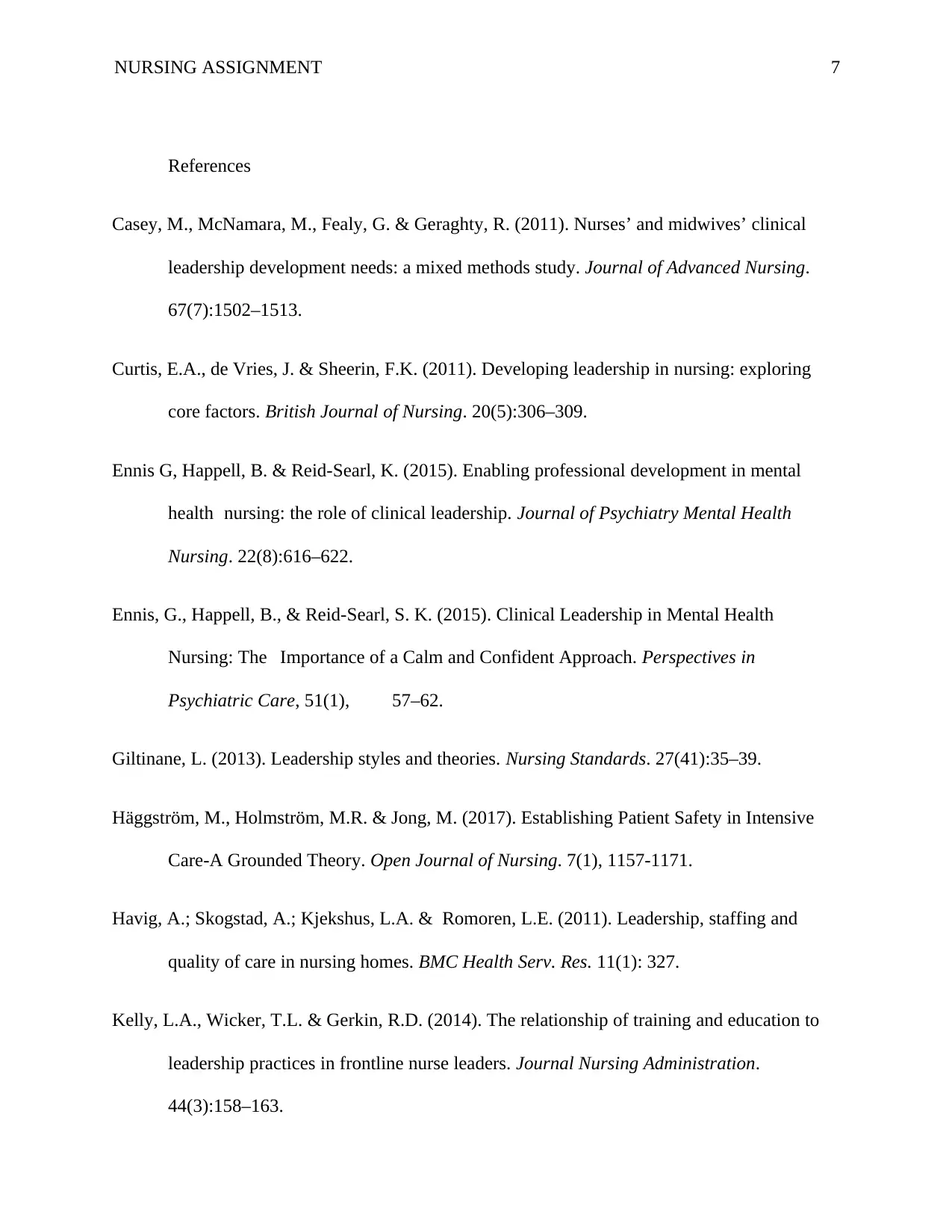
NURSING ASSIGNMENT 7
References
Casey, M., McNamara, M., Fealy, G. & Geraghty, R. (2011). Nurses’ and midwives’ clinical
leadership development needs: a mixed methods study. Journal of Advanced Nursing.
67(7):1502–1513.
Curtis, E.A., de Vries, J. & Sheerin, F.K. (2011). Developing leadership in nursing: exploring
core factors. British Journal of Nursing. 20(5):306–309.
Ennis G, Happell, B. & Reid-Searl, K. (2015). Enabling professional development in mental
health nursing: the role of clinical leadership. Journal of Psychiatry Mental Health
Nursing. 22(8):616–622.
Ennis, G., Happell, B., & Reid-Searl, S. K. (2015). Clinical Leadership in Mental Health
Nursing: The Importance of a Calm and Confident Approach. Perspectives in
Psychiatric Care, 51(1), 57–62.
Giltinane, L. (2013). Leadership styles and theories. Nursing Standards. 27(41):35–39.
Häggström, M., Holmström, M.R. & Jong, M. (2017). Establishing Patient Safety in Intensive
Care-A Grounded Theory. Open Journal of Nursing. 7(1), 1157-1171.
Havig, A.; Skogstad, A.; Kjekshus, L.A. & Romoren, L.E. (2011). Leadership, staffing and
quality of care in nursing homes. BMC Health Serv. Res. 11(1): 327.
Kelly, L.A., Wicker, T.L. & Gerkin, R.D. (2014). The relationship of training and education to
leadership practices in frontline nurse leaders. Journal Nursing Administration.
44(3):158–163.
References
Casey, M., McNamara, M., Fealy, G. & Geraghty, R. (2011). Nurses’ and midwives’ clinical
leadership development needs: a mixed methods study. Journal of Advanced Nursing.
67(7):1502–1513.
Curtis, E.A., de Vries, J. & Sheerin, F.K. (2011). Developing leadership in nursing: exploring
core factors. British Journal of Nursing. 20(5):306–309.
Ennis G, Happell, B. & Reid-Searl, K. (2015). Enabling professional development in mental
health nursing: the role of clinical leadership. Journal of Psychiatry Mental Health
Nursing. 22(8):616–622.
Ennis, G., Happell, B., & Reid-Searl, S. K. (2015). Clinical Leadership in Mental Health
Nursing: The Importance of a Calm and Confident Approach. Perspectives in
Psychiatric Care, 51(1), 57–62.
Giltinane, L. (2013). Leadership styles and theories. Nursing Standards. 27(41):35–39.
Häggström, M., Holmström, M.R. & Jong, M. (2017). Establishing Patient Safety in Intensive
Care-A Grounded Theory. Open Journal of Nursing. 7(1), 1157-1171.
Havig, A.; Skogstad, A.; Kjekshus, L.A. & Romoren, L.E. (2011). Leadership, staffing and
quality of care in nursing homes. BMC Health Serv. Res. 11(1): 327.
Kelly, L.A., Wicker, T.L. & Gerkin, R.D. (2014). The relationship of training and education to
leadership practices in frontline nurse leaders. Journal Nursing Administration.
44(3):158–163.
Paraphrase This Document
Need a fresh take? Get an instant paraphrase of this document with our AI Paraphraser
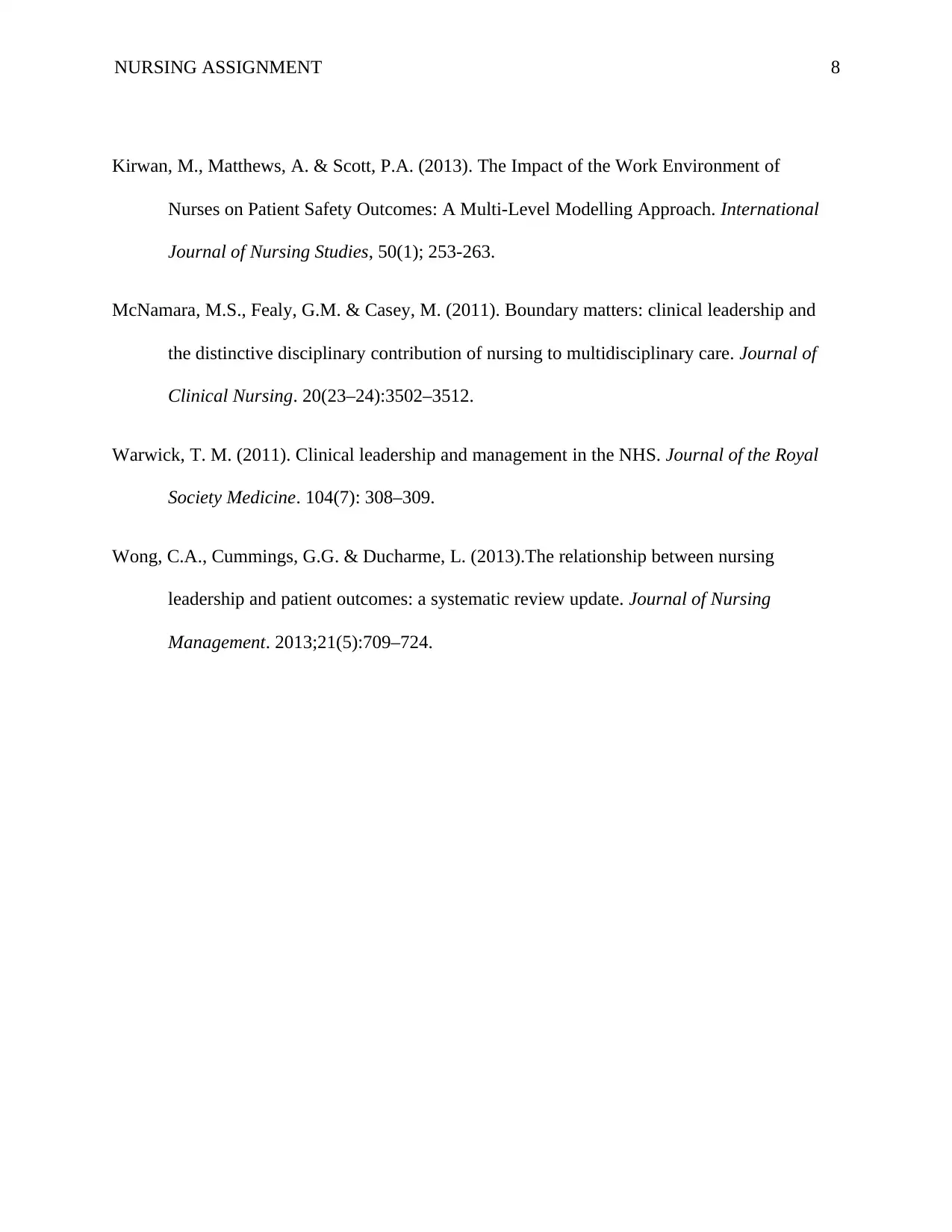
NURSING ASSIGNMENT 8
Kirwan, M., Matthews, A. & Scott, P.A. (2013). The Impact of the Work Environment of
Nurses on Patient Safety Outcomes: A Multi-Level Modelling Approach. International
Journal of Nursing Studies, 50(1); 253-263.
McNamara, M.S., Fealy, G.M. & Casey, M. (2011). Boundary matters: clinical leadership and
the distinctive disciplinary contribution of nursing to multidisciplinary care. Journal of
Clinical Nursing. 20(23–24):3502–3512.
Warwick, T. M. (2011). Clinical leadership and management in the NHS. Journal of the Royal
Society Medicine. 104(7): 308–309.
Wong, C.A., Cummings, G.G. & Ducharme, L. (2013).The relationship between nursing
leadership and patient outcomes: a systematic review update. Journal of Nursing
Management. 2013;21(5):709–724.
Kirwan, M., Matthews, A. & Scott, P.A. (2013). The Impact of the Work Environment of
Nurses on Patient Safety Outcomes: A Multi-Level Modelling Approach. International
Journal of Nursing Studies, 50(1); 253-263.
McNamara, M.S., Fealy, G.M. & Casey, M. (2011). Boundary matters: clinical leadership and
the distinctive disciplinary contribution of nursing to multidisciplinary care. Journal of
Clinical Nursing. 20(23–24):3502–3512.
Warwick, T. M. (2011). Clinical leadership and management in the NHS. Journal of the Royal
Society Medicine. 104(7): 308–309.
Wong, C.A., Cummings, G.G. & Ducharme, L. (2013).The relationship between nursing
leadership and patient outcomes: a systematic review update. Journal of Nursing
Management. 2013;21(5):709–724.
1 out of 8
Related Documents
Your All-in-One AI-Powered Toolkit for Academic Success.
+13062052269
info@desklib.com
Available 24*7 on WhatsApp / Email
![[object Object]](/_next/static/media/star-bottom.7253800d.svg)
Unlock your academic potential
Copyright © 2020–2025 A2Z Services. All Rights Reserved. Developed and managed by ZUCOL.




